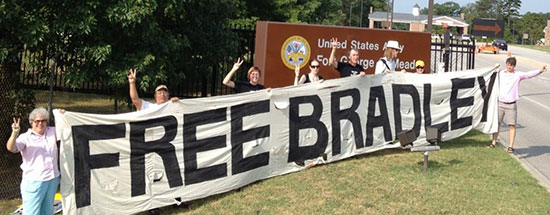Report from July 16th motion hearing and vigil
July 16, 2012. By the Bradley Manning Support Network.
- Detailed notes from the court room proceedings coming very soon
Supporters held a vigil outside the gates of Fort Meade during Bradley Manning’s motion hearing on Monday. There they unveiled a large “Free Bradley” banner to announce the trial to those passing by – countering in some small way the government’s attempts to maintain a low profile. Soon after setting up, spirits were lifted even more when a large RV passed by honking in support. On the RV “Free Bradley Manning” and “WikiLeaks” had been painted across its side: “Occupy the Roads”, a roaming activist art project that has been traveling from protest to protest across the country.
After about two hours supporters were ready to move into the courtroom, where after passing a security checkpoint at the gate, and the other at the courtroom, they were seated, and Judge Lind initiated the proceedings.
The first morning covered the defense motion to dismiss the “1030” specifications charge of unauthorized access to the database which contained the diplomatic cables Bradley Manning allegedly gave to WikiLeaks. Many hours were spent discussing the software program “wget,” which is a kind of automated web browser that can be used to download files from the Internet. The prosecution holds that Bradley Manning did not have authorization to use, or to install, this software. The defense however made the stronger argument, showing that Bradley Manning may not have had authorization to download the software, but clearly he did have authorization to access the material. Given this, the defense’s motion asked that the charge be dropped for failing to specify an offense.
In the afternoon, the court session began with discussions between Judge Lind, the defense, and the prosecution in regards to a protective order which restricted what information could be released to the public on defense lawyer David Coombs’ blog. The prosecution had asked that they be removed from the process of vetting the defense’s publishing of court documents. We learned that so far there have been two instances of classified information having been leaked within the trial. The prosecution wanted put the entire burden of vetting the documents on the defense. The defense however objected, insisting that the prosecution must remain part of the process. Judge Lind agreed, and adjusted the process such that the prosecution would have five days to approve or object, after the defense submitted documents.
The day concluded on the very important defense motion for “specific instructions” on the 104 charge of “aiding the enemy”. The government was wrong, Coombs argued, to try to apply the aiding the enemy charge, which can carry a death penalty (although the government will not be seeking this in this case). Coombs pointed out, in fact, that this was a precedent setting case, in that no one had ever before been charged with “aiding the enemy” for posting information on the Internet. Had the information been posted to the New York Times instead of WikiLeaks, Coombs argued, they wouldn’t be talking about aiding the enemy, they would instead be talking about the unauthorized transmission of information.
Much debate surrounded Bradley Manning’s intent, and the relevance of that intent to the charge of ‘aiding the enemy.’ Particularly, the interpretation of “knowing” became central to the debate. The prosecution argued that it be given its “ordinary” meaning, but as the debate developed it became clear there was no such ordinary definition.
Was the information “knowingly” posted to a particular place on the Internet that would be accessed by “the enemy”? Or was it posted “wrongfully and wantonly”? The afternoon was filled with such questions of semantics. The judge’s instructions as to how to interpret the language used in the charges will have serious consequences for the trial.
Check back soon as we will be posting more detailed notes from the trial.











